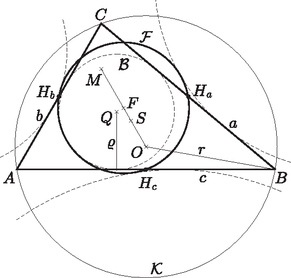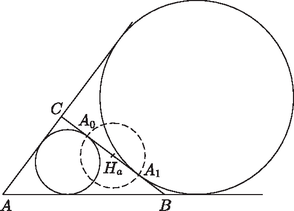| Cím: | Feuerbach's circle touches the tangent circles | |
| Szerző(k): | Zoltán Füredi | |
| Füzet: | 2005/februári melléklet, 7 - 13. oldal |  PDF | MathML PDF | MathML |
|
A szöveg csak Firefox böngészőben jelenik meg helyesen. Használja a fenti PDF file-ra mutató link-et a letöltésre. 1 Notations The three sides of triangle are denoted by , and the usual way. Let denote the circumscribed circle with centre , and radius ; denotes the inscribed circle, its centre is , its radius is , and the area of the triangle is , its semiperimeter is , its centroid is , its orthocentre is , and the midpoints of the sides are , and . Heron's formula expresses the area of the triangle in terms of the sides,  Figure 1 Feuerbach's circle Let denote the circle passing through the midpoints of the sides. Since triangle is obtained from triangle by a scaling down of centre and factor , the radius of is and its centre is , and it is adjacent to Euler's line of the triangle: is the midpoint of the segment , trisects and . Euler (1707‐1783) already knew that passes through the feet of the altitudes and the midpoints of segments joining and the vertices. The reason why is still called Feuerbach's circle is the following nice theorem: In 1822, in his doctoral dissertation Karl Wilhelm Feuerbach (1800‐1834) calculated the distance of the centres of the circles in question. He showed that . As all data of the triangle can be expressed with , and , if not in other way, but implicitly, as a root of (simultaneous) equation(s), this calculation can be carried out, at least in principle. If points , and are placed in a coordinate system as points , and , then only two parameters are needed for the calculations. The calculation may result in higher and higher degree equations, which are more and more difficult to handle. Therefore, the majority of the proofs of the theorem use vectors. The calculation below stands out with its relative shortness. I learnt the most significant elements of the argument (Lemma 1) more than 30 years ago at István Reiman's extracurricular problem-solving course, and it can be found in István Reiman's book titled Geometry and its Frontiers (Gondolat Kiadó, Budapest, 1986). It is more convenient to determine the square of the distances: avoiding square roots, only rational fractions come in sight. From (1) and (2) it is immediately known how to express the last two terms of with , and . For the calculation of below only , , and are used. Vectors The task becomes much simpler with the right choice of the origin. In our case let the vector pointing from point to be denoted by . Then . For any origin . As the starting point of the position vectors is and points , , and are all adjacent to Euler's line, it follows that and
Proof. Let denote the fraction on the right-hand side of (4). We show that its end-point is lying on the bisectors of the angles, respectively. The length of vector is , thus is the unit vector from towards . Similarly, is the unit vector towards . Hence the end-point of the sum of these two, i.e. lies on the angle bisector at . Any point of the bisector line can be obtained if the sum is multiplied by a scalar and added to . Removing fractions yields the parametric vector-equation of the angle bisector of : Besides basic properties of vectors (commutativity of addition, linear combination) the notion of scalar product is also needed. As the product of a vector with itself is the square of its length, an arbitrary distance or its square can be calculated: . Besides the commutativity and a certain kind of associativity of the dot product, only the values of the products , and are needed. As , we get that
Subtract (9) from the sum of equations (6) and (8): Remarks 1. Prove that the vector pointing to the centre of the circle escribed to side is Based on Euler's formula (7), prove Poncelet's theorem for . Proof by inversion The simplest proof of Feuerbach's theorem is presented, which has been found by M'Clelland (1891) and Lachlan (1893) independently, and has been adopted by most textbooks (e.g. D. Pedoe: Circles, MAA publication, 1957, 1979, 1995). The proof of the main idea (Lemma 2) below is new and slightly simpler than usual. Let denote the point of tangency of the inscribed circle on the side , and the point of tangency of circle escribed to side , and, finally let be the common axis of symmetry of these two circles, the interior angle bisector at . These two circles have 4 common tangent lines, the sides , , , and a fourth line , the reflection of about . Let and be the reflections of vertices and about , in this case , . As and , the midpoint of segment is and its length is . Suppose that and let denote the inversion with respect to circle of diameter . In this case , , .  Figure 2  Figure 3 It still has to be proved that . As contains the centre of the inversion, , its image is a line. We prove that the images of and are adjacent to the line . Consider , the case of is similar. Let be the intersection of lines and . The similarity of triangles and implies that Finally, since is the common tangent line of and , so is a common tangent (circle) of the images of these two circles. Finally, the same holds for any other escribed circle instead of , the circle touches all four tangent circles, indeed. Appendix, some properties of inversion Inversion with respect to a circle of centre and radius is a bijection of the points apart form of the plane so that the image of point is on the ray starting from and passing through such that . This is an involution, i.e. . ‐ The image of a straight line through is itself (more precisely, .) ‐ If , then its image is a circle passing through . ‐ The image of a circle containing is a straight line not containing . ‐ The image of a circle not containing is another circle. Their exterior point of similarity is . ‐ Inversion preserves tangency, and the images of tangent circles and lines also touch each other. Moreover, inversion also preserves angles. 1Research supported in part by the Hungarian National Science Foundation under grants OTKA T 032452, T 037846 and by the National Science Foundation under grant DMS 0140692.2More information on Poncelet's theorem can be found in András Hraskó's article in KöMaL 2002/1, pp. 21‐31. (in English). |